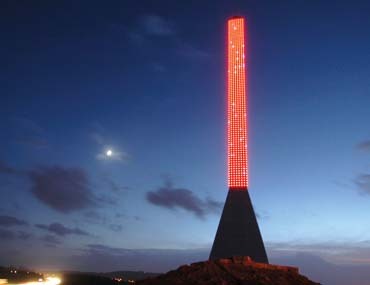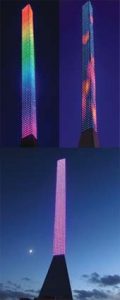Last November, I suggested that signmakers, to gain new profits, study electronic digital signage (EDS) and its place in advertising media. At that writing, I recommended the Power Sign Conference (Las Vegas) as a place to learn more about the EDS industry. (EDS, known as "digital signage" in the retail-advertising field, is sometimes referenced as "programmable" or "dynamic" signage.)
After that conference, I attended a Strategy Institute Conference — "Building Your Successful Digital Signage Business" — in Chicago. Because of what I learned there, I’m now convinced that it’s critical for signmakers to focus on the EDS industry’s continuing evolution.
As noted above, the ad industry uses the term "digital signage" to represent almost all changing-message display systems — text-messaging systems, active-matrix LEDs, flat-panel LCDs or plasma screens. My research shows the greatest system growth — usage — appears at Wal-Mart, Best Buy, Costco and other retailers’ in-store networks.
These retailers’ networks may not seem to directly correlate with outdoor-programmable signs, but, when studying in-store networks, I see a strong crossover benefit.
In-store, programmable, digital networks are similar to the outdoor-programmable displays, and both applications specifically sell products or services. In-store media may serve as POP advertising for items sold at that location, or they might direct the consumer to another store area. The display can also reference an upcoming event. Whatever the case, the concept is the same. Both convey sales messages to the buyer while he or she is in a particular place.
Proving effectiveness
Because of the sheer size of evolving in-store networks, EDS gets significant attention. Premier Retail Networks (PRN), for example, broadcasts on more than 250,000 screens in more than 6,000 stores. This attention has created success-measurement systems that validate results, which, if positive, mean a greater share of the ad-media pie for EDS. In 2005, Procter & Gamble Corp. diverted 5% of its television budget to the new digital media, a first for a major manufacturing conglomerate.
What does this mean for the outdoor-message display industry? It means these digital-media measurement systems can also validate outdoor-display’s effectiveness. Several media-measurement firms have studied, and continue to study, the new media. Here are their websites:
• Arbitron Outdoor (www.arbitron.com)
• Nielsen New Media Services (www.nielsenmedia.com)
• Forrester Research Inc. (www.forrester.com)
• Frost and Sullivan (www.frost.com)
Clear Channel Outdoor, one of the world’s largest out-of-home media companies, recently converted seven, Cleveland-based static billboards into digital, programmable LED displays. The results were astounding.
According to Michael Hudes, senior VP of Clear Channel, its measurement systems showed the bulletin’s revenues had risen to $2 million from a gross, prior to the conversion, of $375,000. The increase occurred after the deadline for the traditional, national, account-buying season; therefore, the sales uplift didn’t entail any national advertising that otherwise would’ve been included.
Simon Property Group, the world’s largest mall developer, has systems that measure pilot projects — full-color LED systems on main pylon signs — at each entrance to Southern California’s Westminster Mall. These signs broadcast brand awareness for mall retailers’ products and services, and other relevant information.
Ad agencies could formerly claim no real validation for electronic signs. Today, the critical measurement of outdoor displays, such as at Westminster Mall, indicates the niche, message-center business is becoming mainstream. Because of this, many agencies are on board as buyers.
Ad language
Until recently, I’ve found a disconnect between the sign industry and advertising agencies. The two groups speak different languages and often work on the same project from radically different angles. Now, however, is a good time to learn their lingo and, conceivably, how to sell to them.
Here are some ad-agency digital media terms:
• Day-parting: Ads that change during the day to match the demographics of the passing public
• Recency: Suggests that shoppers are most likely to buy the brand whose advertising they saw most recently
• Relevancy: Content that is relevant to the public
• Sales lift: The measurable increase in sales as a consequence of an effective merchandising display
The ad-agency’s model requires validation for their clients. Agencies must prove the size of the audience and the frequency of the advertising, and show evidence the ads ran. They also require some measurement of the ad’s impact. To learn more, take time to peruse their websites.
For lesser jobs, conduct your own survey. A traffic count obtained from the local government, multiplied by an average of 1.35 per person, provides the number of daily exposures. Validation software in the sign-operating system — showing when each ad ran and for how long — will provide performance proof.
Modern EDS systems work best when used to the fullest, and an ad agency can be an excellent asset if you’re dealing with a sophisticated buyer. It can help you create content that’s relevant to your customer’s long-term media strategy. Think in terms of retail centers, automobile dealerships, chains, big-box stores, supermarkets, specialty stores, pharmacies and tire centers.
Although the agency cost for such tasks may seem outrageous, a well-placed, retail display in a high-traffic location needs such commitment. Its specialized content must offer relevant, day-part information.
In time, EDS will dilute other signage systems because a programmable EDS is a powerful, provable media option for many sign buyers.


 Photo Gallery1 week ago
Photo Gallery1 week ago
 Ask Signs of the Times1 week ago
Ask Signs of the Times1 week ago
 Paula Fargo5 days ago
Paula Fargo5 days ago
 Real Deal2 days ago
Real Deal2 days ago
 Benchmarks2 weeks ago
Benchmarks2 weeks ago
 Photo Gallery5 days ago
Photo Gallery5 days ago
 Women in Signs1 week ago
Women in Signs1 week ago
 Women in Signs1 week ago
Women in Signs1 week ago

















